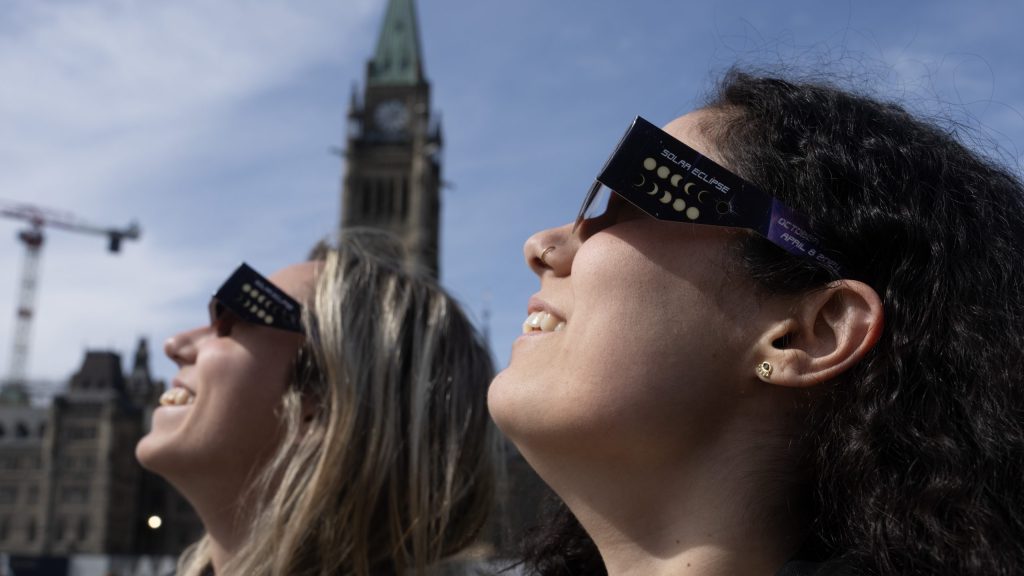Historic solar eclipse passes through Ottawa

The nation’s capital experienced the solar eclipse that made its way across much of eastern and central Canada but the city wasn’t in the path of totality — when the moon fully blocks out the sun.
Starting at 3:25 p.m. on Monday, the sun was only 99 per cent covered for around three minutes. That means there was no safe time to look at the sun without eye protection in the nation’s capital.

Kingston, Belleville, Brockville and Cornwall were all within the path of totality, creating night-like darkness for a short time. In Kingston, it reached maximum totality from 3:22 to 3:25 p.m.
Advertisement
Patty Hone from Orillia, Ont. who was in Kingston, says she bought her glasses one year ago, and that today’s eclipse is so far exceeding her year-long anticipation as the sun’s visibility has been reduced to a sliver.
WATCH: Darkness blankets Niagara Falls during solar eclipse
The skies go dark in Niagara Falls as the sun disappears behind the moon during the rare celestial event.
According to the University of Toronto’s Dunlap Institute for Astronomy and Astrophysics, the solar eclipse’s path of totality will exit North America at 3:46 p.m.
Experts say that while looking directly at the sun at any time is dangerous, it’s even more so during an eclipse because the lack of brightness makes it painless.
“Looking directly at the sun at any time without protection make cause damage to your retina, called ‘Eclipse Blindness’,” wrote city officials in a release. “Damage can occur without any sensation of pain [and] the injury can be temporary or permanent.”
Advertisement
How to prepare for the solar eclipse
According to the American Astronomical Society (AAS), only approved eye protection — ISO Standard 12312-2:2015 solar filters that have the manufacturer’s name and address printed on the product — are safe to wear while looking at an eclipse. The AAS has published a list of approved solar viewer manufacturers on their website.
The AAS also has a list of tips to make sure your viewing is safe:
- Always inspect your solar filter before use; if scratched, punctured, torn, or otherwise damaged, discard it. Read and follow any instructions printed on or packaged with the filter.
- Always supervise children using solar filters.
- If you normally wear eyeglasses, keep them on. Put your eclipse glasses on over them, or hold your handheld viewer in front of them.
- Stand still and cover your eyes with your eclipse glasses or solar viewer before looking up at the bright Sun. After looking at the Sun, turn away and remove your filter — do not remove it while looking at the Sun.
- Do not look at the uneclipsed or partially eclipsed Sun through an unfiltered camera, telescope, binoculars, or other optical device.
- Do not look at the Sun through an unfiltered camera, telescope, binoculars, or any other optical device while using your eclipse glasses or handheld solar viewer in front of your eyes — the concentrated solar rays could damage the filter and enter your eyes, causing serious injury.
- Seek expert advice from an astronomer before using a solar filter with a camera, telescope, binoculars, or any other optical device; note that solar filters must be attached to the front of any telescope, binoculars, camera lens, or other optics.
Experts also warn that sunburn is another common risk associated with viewing an eclipse. They suggest wearing sunscreen, a hat and protective clothing to prevent skin damage.
The last total solar eclipse that was visible in Ottawa was on Feb. 26, 1979.
With files from the Canadian Press.
